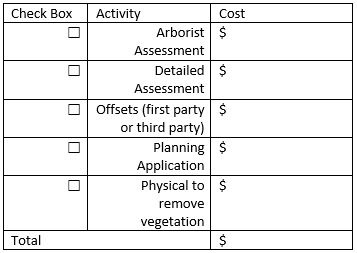Removing native vegetation
There is legislation in place which protect native vegetation in Victoria. It is illegal to remove native vegetation unless you have a permit, an exemption or appropriate permissions. Native vegetation is defined in the planning scheme, clause 73.01, as ‘plants that are indigenous to Victoria, including trees, shrubs, herbs and grasses’.
This is a basic guide regarding the removal of native vegetation.
For further information regarding the removal of Native Vegetation visit the Department of Energy, Environment and Climate Action (DEECA) website.
The native vegetation removal process has been simplified into 8 main steps below.
Step 1
Avoid the removal, destruction or lopping of native vegetation.
Step 2
Minimise impacts from the removal, destruction or lopping of native vegetation that cannot be avoided.
Step 3
Contact council to discuss your proposal. Pre-planning is strongly recommended to ensure appropriate time is provided to discuss your proposal and opportunities to meet avoid and minimise principles.
There may be exemptions that apply to your situation – refer to DEECA guidelines on the exemptions and contact council to confirm if an exemption does apply.
If an exemption cannot be applied the steps below will provide you with further guidance.
Step 4
Determine where native vegetation will be removed including loss of native grasses (e.g. areas where 25% of more of the understory is native), loss of mature canopy trees (i.e. greater than 3m) and loss of mature trees resulting from assumed losses or consequential removal such as Tree Protection Zone (TPZ) encroachment.
Tree Protection Zone (TPZ) encroachment and loss - is an area around a tree that is protected from disturbance to prevent the deterioration of the trees condition.
An arborist can determine whether a tree will remain viable following the completion of an activity (e.g. building a shed building or a channel near a native tree). Trees that are considered unviable following the completion of an activity would require offset credits to compensate for the loss of native vegetation regardless of whether the native vegetation is removed.
Step 5
If native vegetation does need to be removed the assessment pathway would need to be determined:
- basic & intermediate; or
- detailed.
The Native Vegetation Regulation Map will assist you with this.
Step 6
For detailed assessments an accredited assessor will need to complete a detailed assessment & native vegetation removal report.
For basic or intermediate assessments, you can generate a native vegetation removal report via NVRM.
At this stage you need to determine how you wish to secure offsets.
What are Offsets? When native vegetation is removed offset credits need to be secured to compensate for the loss of native vegetation.
How can you secure offsets?
First Party Offsets - If you have appropriate native vegetation on your land you could gain offset credits by entering into a s173 agreement with council or s69 agreement with DEECA or Trust For Nature (TFN). An accredited assessor, the NVRM tool and/or the relevant statutory authority (DEECA, TFN or Council) can assist you with this.
Third Party Offsets - You can purchase credits, if available, via an accredited broker to secure third party offsets. In this situation you are purchasing credits from another landholder who has entered into a s69 agreement with either DEECA or TFN. These third party offsets will be required in the Local Government or Catchment area.
For more information visit DEECA offsets for the removal of native vegetation’ webpage.
Step 7
Submit your planning application to council. Details to include with your planning application listed below.
- Photographs of the native vegetation planned for removal and/or considered lost from TPZ encroachment.
- The native vegetation removal report generated from NVIM.
- How you plan on securing offsets, third party or first party (s173 or s69 with TFN or DELWP)
- If relevant the arborists assessment to understand loss from TPZ encroachment.
- If relevant the detailed assessment completed by the accredited assessor.
Step 8
Your application is not guaranteed to be approved. If your application is approved, you will need to secure offsets and provide evidence to council prior to any removal taking place.
Removal of native vegetation without a permit is illegal. You cannot apply for a retrospective permit.
If cultural heritage values (e.g. scar trees) are impacted Aboriginal Heritage Act or if wildlife habitat is destroyed further penalties apply for those found guilty of an offence under the Wildlife Act.
Costs
There are costs associated with the removal of native vegetation. Before you proceed it is best to understand what the likely cost will be. You could obtain quotes and contact council as a part of your research. Its best to understand what the total cost will be before you commit any funds.
It is important as part of any development, to weigh up the cost to remove native vegetation (e.g. consultant costs, permit costs, physical removal, biodiversity loss, aesthetic loss, heritage loss) as you would any other factor in your development.
Avoid and minimise is a statutory requirement, that also assists in considering options to reduce your costs and provide an opportunity to explore more cost effective options. This does not mean removal without a permit, as this can result in serious fines.
